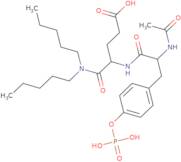N-Acetyl-o-phosphono-Tyr-Glu dipentylamide
CAS: 190078-50-3
Ref. 3D-QHA07850
| 1mg | Descontinuado | ||
| 5mg | Descontinuado | ||
| 10mg | Descontinuado | ||
| 25mg | Descontinuado | ||
| 50mg | Descontinuado |
Informação sobre produto
- <span class="text-smallcaps">L</smallcap>-α-Glutamine, N-acetyl-O-phosphono-<smallcap>L</span>-tyrosyl-N,N-dipentyl-
- Ac-Tyr(Po3H2)-Glu-N(C5H11)2
- N-Acetyl-O-Phosphono-L-Tyrosyl-N,N-Dipentyl-L-Alpha-Glutamine
- N-Acetyl-O-phosphono-<span class="text-smallcaps">L</smallcap>-tyrosyl-N,N-dipentyl-<smallcap>L</span>-α-glutamine
- N-Acetyl-O-phosphono-L-tyrosyl-N,N-dipentyl-L-a-glutamine
- Potent Dipeptide Inhibitor Of The Pp60C-Src Sh2 Domain
N-Acetyl-o-phosphono-Tyr-Glu dipentylamide is a synthetic, nonproteinaceous compound that binds to the surface of muscle fibers and is able to deform them. This drug has been shown to be useful for studying the effects of contactor stiffness on the deformation of muscle fibers and for quantifying the amount of blood platelets in the blood. N-Acetyl-o-phosphono-Tyr-Glu dipentylamide has also been found to have an antigen binding affinity for human leukocyte antigens (HLA) and is used as a reagent in identifying HLA proteins in various body fluids. This drug is also being studied as a potential therapeutic agent for autoimmune diseases, where it may bind to antibodies that are present in human blood and prevent their binding with other cells. In addition, this compound has been used in gene transcription studies because it can bind to DNA and inhibit mRNA synthesis.





